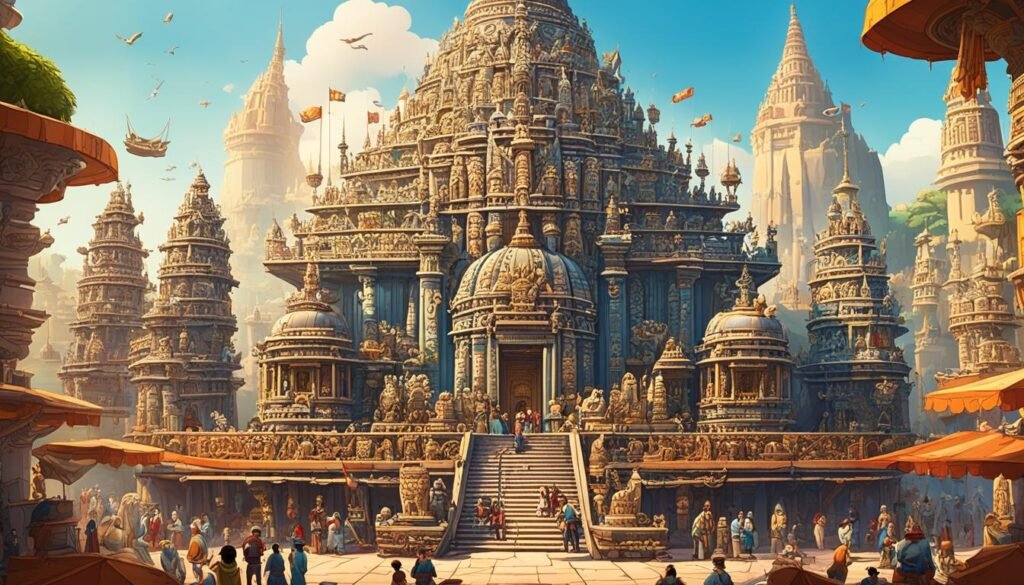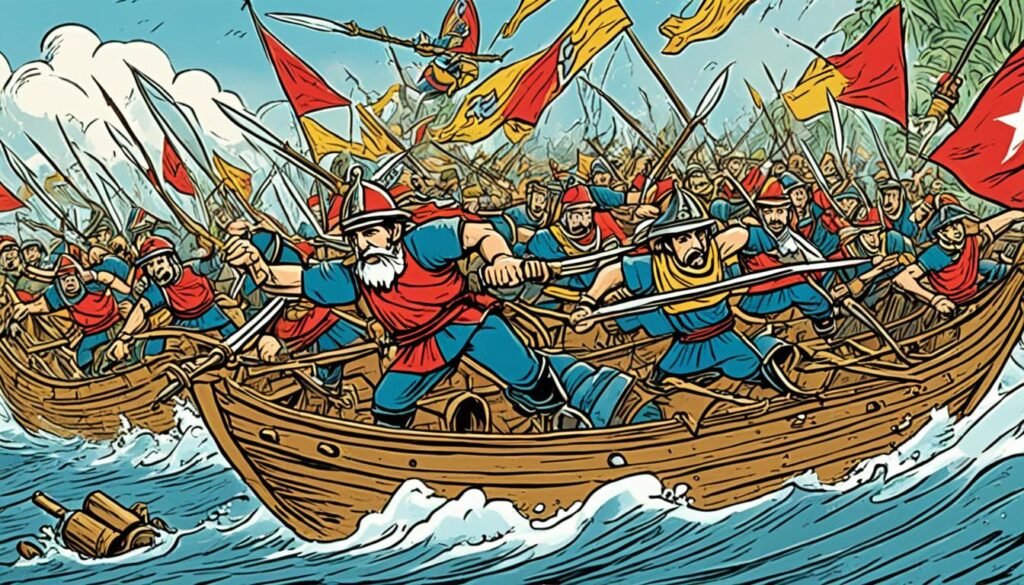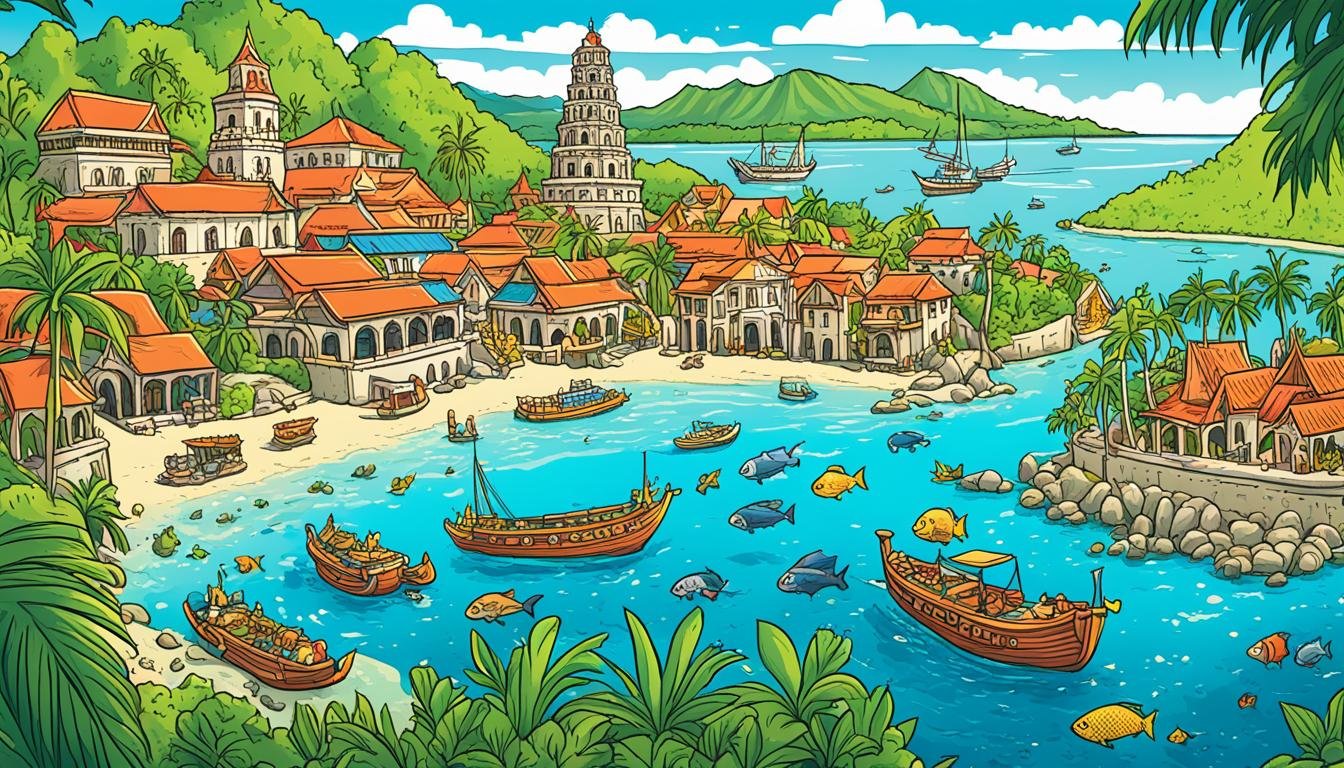Imagine a time when the lush landscapes of Cebu were ruled by an ancient kingdom, where legends were born and legends were made. In the heart of this land, there stood a ruler, a pioneer who laid the foundation for a kingdom that would shape the course of history. This ruler was Sri Lumay, the first Rajah of the Rajahnate of Cebu, an ancient civilization that thrived centuries ago.
Legend has it that Sri Lumay, a prince of the illustrious Chola dynasty, set foot on the shores of the Visayas region and decided to make it his home. With determination and ambition, he established his own kingdom in Cebu, uniting the surrounding areas under his rule. Sri Lumay’s reign brought about a cultural renaissance, governance reforms, and flourishing trade, transforming Cebu into a thriving center of civilization.
However, as with all tales of power and influence, Sri Lumay’s kingdom faced its share of challenges. The arrival of Spanish conquistadors in the 16th century marked the end of the Rajahnate of Cebu, but the legacy of Sri Lumay’s rule continues to reverberate through the annals of history.
Join us on a journey back in time as we delve into the life and legacy of Sri Lumay, exploring the wonders of the ancient kingdom of Cebu and unraveling the stories that have shaped this remarkable civilization.
Key Takeaways:
- Sri Lumay was the first Rajah of the Rajahnate of Cebu, an ancient kingdom in the Philippines.
- He established his own kingdom in Cebu and ruled over the surrounding areas.
- Sri Lumay’s reign had a significant impact on the culture, governance, and trade in ancient Cebu.
- The kingdom lasted until the arrival of the Spanish conquistadors in the 16th century.
- The legacy of Sri Lumay continues to be remembered and preserved in contemporary Cebuano society.
Unveiling the Legacy of Sri Lumay
Sri Lumay’s legacy is an important part of ancient Cebu’s history. His establishment of the Rajahnate of Cebu laid the foundation for the growth and development of the region. Sri Lumay’s reign introduced various cultural, political, and economic changes that shaped the history of Cebu. His battle tactics against the Moro raiders and his policies for defending the kingdom left a lasting impression. The legacy of Sri Lumay continues to be remembered and preserved in contemporary Cebuano society, highlighting the enduring influence of this ancient ruler.
The Chola Dynasty Link and the Founding of Rajahnate of Cebu
Sri Lumay, the first Rajah of Cebu, is believed to have hailed from the prestigious Chola dynasty, a ruling dynasty of Tamil and Malay origin from South India. As a commissioned governor, Sri Lumay was sent by the Chola emperor to establish a base in the Visayas region. However, he decided to rebel against the Chola dynasty and forge his own path as an independent ruler.
With his unwavering determination and exceptional leadership skills, Sri Lumay successfully established his own polity in Cebu, founding the renowned Rajahnate of Cebu. This marked the beginning of his illustrious reign as the first Rajah of Cebu, setting the stage for the kingdom’s prosperous future.
The Chola dynasty link in Sri Lumay’s origins not only adds a fascinating aspect to his story but also underscores the rich cultural exchanges and historical connections between South India and the Philippines in ancient times.

Legend has it that Sri Lumay’s journey from being a commissioned governor to an autonomous ruler exemplified his strong will and desire to carve his own path. This transition showcases his ability to navigate complex political landscapes, defy conventional norms, and establish an independent and influential kingdom that would leave a lasting impact on the history of Cebu and the Philippines.
The Epic Tale of Aginid and the Visayan Connection
The rich cultural heritage of Sri Lumay’s reign is beautifully captured in the epic tale of Aginid, Bayok sa atong Tawarik. This Visayan oral history provides invaluable insights into the events and achievements during Sri Lumay’s time as the founder of the Rajahnate of Cebu.
The Aginid epic serves as a significant tool for preserving the history and traditions of the Visayan people. Passed down through generations, this epic story paints a vivid picture of the courageous battles, political intrigues, and cultural transformations that defined Sri Lumay’s reign.
The Aginid epic is not only a means of preserving historical accounts but also a source of inspiration for contemporary Visayan culture. The epic showcases the cultural values, language, and societal practices that emerged during Sri Lumay’s rule. Through his contributions to Visayan culture, Sri Lumay left an indelible mark on the identity and heritage of the Visayan people.
The Aginid epic serves as a testament to the enduring influence of Sri Lumay and his legacy in shaping the cultural fabric of the Visayan region. It reminds us of the rich tapestry of myths, legends, and historical narratives that continue to inspire and unite the Visayan people today.
The Geopolitical Influence of the Ancient Cebu Kingdom
The ancient Cebu kingdom, under the rule of Sri Lumay and his successors, held significant geopolitical influence in the region. Located strategically in the central Philippines, the kingdom controlled vital trade routes and established diplomatic relations with neighboring polities. This allowed the Cebu kingdom to become a regional power and a prominent player in Southeast Asia during its time.
Sri Lumay’s administration and governance played a crucial role in shaping the kingdom’s geopolitical influence. His effective leadership and ability to maintain political stability and economic growth strengthened the kingdom’s regional power status. The Cebu kingdom’s economic and military strength made it a formidable force, securing its position as a key player in the region.
Through their control of trade routes and diplomatic alliances, Sri Lumay and his successors ensured the prosperity and prominence of the ancient Cebu kingdom. Their influence extended beyond the local sphere, leaving a lasting legacy in the geopolitical landscape of Southeast Asia during that era.
Sri Lumay’s Battle Tactics Against Moro Raiders
Sri Lumay, the esteemed ruler of the ancient Rajahnate of Cebu, was renowned for his exceptional battle tactics against the Moro raiders from Mindanao. In the face of relentless threats, Sri Lumay devised a strategy that would both safeguard the kingdom and cripple the enemy.
One of Sri Lumay’s key innovations was the implementation of scorched earth policies. To prevent the Moro raiders from obtaining valuable resources, he ordered the burning of towns and crops, leaving nothing behind. This scorched earth approach denied the enemy access to essential supplies, weakening their forces and inhibiting their ability to sustain lengthy campaigns.

These battle tactics gained Sri Lumay the moniker “Kang Sri Lumayang Sugbu,” which translates to “that of Sri Lumay’s great fire.” It was this nickname that eventually gave rise to the name of the town Sugbu, later known as Cebu. The impact of Sri Lumay’s battle strategies was profound, leaving a lasting impression on Cebu’s defense measures and influencing the entire kingdom’s approach to warfare.
Sri Lumay’s Successors and Continuation of Legacy
After Sri Lumay’s death, his son Sri Bantug was tasked with carrying on his father’s legacy as the ruler of the Cebu kingdom. Sri Bantug took the reins of power and continued the administration and governance of Singhapala, the capital city established by Sri Lumay. Under Sri Bantug’s leadership, the kingdom maintained its stability and prosperity, ensuring a smooth transition from Sri Lumay’s reign.
Rajah Humabon, the son of Sri Bantug, emerged as a key figure in the post-Sri Lumay era. During his rule, an important turning point occurred as Singhapala fell, and Sri Bantug rose to prominence. This period marked a significant shift in Cebu’s history, with Rajah Humabon playing a pivotal role in shaping the kingdom’s destiny.
The events following Sri Lumay’s reign showcased the resilience and adaptability of his successors. Despite the challenges they faced, including the fall of Singhapala, Sri Lumay’s successors continued to carry forward his legacy and contribute to the rich history of Cebu.
The Administration and Governance Under Sri Lumay
Sri Lumay, the first Rajah of Cebu, established a well-structured administration and governance system for the Cebu kingdom. His leadership and governance practices played a crucial role in ensuring the stability and growth of the kingdom during his reign.
Implementing strict policies, Sri Lumay aimed to maintain law and order, protect his people from external threats, and promote economic development. His administration focused on creating a safe and prosperous environment for the residents of the Cebu kingdom.
Through efficient governance, Sri Lumay facilitated trade and commerce, laying the foundation for the economic prosperity of the kingdom. He fostered diplomatic relations with neighboring polities, promoting regional stability and cooperation.
Sri Lumay’s commitment to good governance and effective administration left a lasting legacy in the history of the Cebu kingdom. His vision and leadership set the stage for the success and growth of subsequent rulers and the enduring influence of the Cebu kingdom.

The Economic Transformation During Sri Lumay’s Reign
Sri Lumay’s reign in the Cebu kingdom brought about a remarkable economic transformation. Under his rule, Cebu flourished as a vibrant trading hub, fostering trade relations and commodity exchange with merchants from various regions.
Trade Relations and Commodity Exchange in Cebu
During Sri Lumay’s time, Cebu became a bustling center of trade, attracting merchants from China, Japan, India, and beyond. The kingdom’s strategic location and well-established maritime routes facilitated the exchange of goods, contributing to its economic growth and prosperity.
The Cebu kingdom actively participated in international trade, exporting valuable commodities such as spices, precious metals, ceramics, and textiles. In turn, it imported a wide range of goods, including silk, porcelain, weaponry, and luxury items.
| Exports | Imports |
|---|---|
| Spices (cinnamon, nutmeg, cloves) | Silk |
| Precious metals (gold, silver) | Porcelain |
| Ceramics (jars, plates, bowls) | Weaponry |
| Textiles (cotton, silk) | Luxury items |
Cultural Exchanges with China, Japan, India, and Beyond
The flourishing trade relations during Sri Lumay’s reign also facilitated cultural exchanges between the Cebu kingdom and neighboring regions. Through these exchanges, Cebuanos were exposed to diverse cultural practices, traditions, and ideas.
From China, Cebu received influences in art, architecture, philosophy, and governance. The impact of Chinese culture can still be seen today in the intricate carvings, ceramic artifacts, and architectural styles that have endured over the centuries.
Japan brought influences in craftsmanship, martial arts, and religious practices. Sri Lumay’s reign welcomed Japanese artisans and traders, leading to the diffusion of their skills and cultural traditions in Cebu.
India, a major trade partner, introduced Hindu and Buddhist beliefs, rituals, and iconography to the Cebuanos. The adoption and integration of these religious practices into local culture enriched Cebu’s spiritual landscape.
Sri Lumay’s focus on economic development and trade not only propelled the Cebu kingdom’s economic growth but also fostered cultural exchanges that enriched the local society and left a lasting impact on its traditions, arts, and religious practices.
Religious Syncretism: Hinduism and Buddhism in Pre-Colonial Cebu
Pre-colonial Cebu was a melting pot of cultures and religions, exhibiting a unique phenomenon known as religious syncretism. This concept refers to the blending and integration of different religious beliefs and practices into a cohesive whole. In the case of Cebu, the influences of Hinduism and Buddhism played a significant role in shaping the religious landscape of the region.
Sri Lumay’s reign during the establishment of the Rajahnate of Cebu witnessed the integration of Indian religious traditions into local Visayan culture. The acceptance and patronage of Hindu and Buddhist practices by Sri Lumay and his successors contributed to the religious syncretism prevalent in pre-colonial Cebu.
Hindu and Buddhist concepts, rituals, and iconography became an integral part of Cebuano society. The artistic representations of deities, such as sculptures and reliefs, displayed elements of both Hindu and Buddhist influence. The use of mantras, mudras (hand gestures), and symbolic motifs further showcased the syncretic nature of religious practices in Cebu.
This religious syncretism not only enriched the spiritual lives of the people but also fostered cultural exchange and mutual understanding among different communities. It allowed for a diverse range of religious expressions, accommodating various beliefs and rituals within a single religious framework.
“Religious syncretism in pre-colonial Cebu created a harmonious blend of Hindu and Buddhist traditions, resulting in a rich and culturally vibrant society.”
| Hinduism | Buddhism |
|---|---|
| Worship of Hindu deities such as Shiva, Vishnu, and Devi | Veneration of Buddhist figures such as Buddha and Bodhisattvas |
| Offerings of flowers, incense, and fruits at altars | Practice of meditation, mindfulness, and ethical principles |
| Rituals and ceremonies based on Vedic scriptures | Observance of Buddhist festivals and precepts |
| Belief in karma, reincarnation, and liberation | Emphasis on impermanence, enlightenment, and the Middle Way |
Architectural Marvels: The Capital City of Singhapala
Sri Lumay’s capital city, Singhapala, was a testament to the architectural marvels and urban planning of the ancient Cebu kingdom. The city stood as a symbol of prosperity and grandeur, showcasing the kingdom’s cultural, political, and economic achievements.
Amidst the bustling streets and bustling marketplaces, Singhapala’s magnificent structures captivated both locals and visitors alike. From towering temples to intricately designed palaces, every architectural masterpiece was a reflection of Sri Lumay’s vision for a strong and thriving Cebu kingdom.
The layout of Singhapala was carefully planned to facilitate the efficient flow of people, goods, and ideas. Wide boulevards, intricate waterways, and well-defined districts created a harmonious urban landscape that fostered cultural exchange and economic growth.
The city’s architectural wonders attracted merchants, scholars, and diplomats from distant lands, making Singhapala a hub of cultural, political, and economic activities. It was a melting pot of diverse traditions, ideas, and influences, further enriching the vibrant tapestry of the kingdom.
To this day, the remnants of Singhapala’s architectural heritage continue to inspire awe and admiration, a testament to the greatness of Sri Lumay’s reign and the enduring legacy of the ancient Cebu kingdom.
Sri Lumay: The Semi-Legendary Figure in Philippine History
Sri Lumay, although considered a semi-legendary figure in Philippine history, has left a lasting impact on the region. Historical records about his life are limited, but his story and legacy have been passed down through oral traditions and written accounts that emerged long after his reign. Sri Lumay’s significance in Philippine history lies in his establishment of the Rajahnate of Cebu, an ancient kingdom that played a pivotal role in shaping the culture and history of the region.

Despite the lack of detailed historical documentation, Sri Lumay’s influence is felt throughout Philippine history. His role as the founder of the Rajahnate of Cebu demonstrates his leadership and vision for the region. The kingdom he established became a center of governance, trade, and cultural exchange.
The limited historical information about Sri Lumay adds to the intrigue surrounding his legacy. It showcases the importance of oral traditions and the preservation of ancient history. Sri Lumay’s story serves as a reminder of the rich cultural heritage of the Philippines and the enduring impact of its ancient rulers.
Defending the Rajahnate: Military Strategies of Sri Lumay
Sri Lumay, the founder of the Rajahnate of Cebu, implemented effective military strategies to defend his kingdom from external threats, particularly the Moro raiders. His astute defense measures and legacy of warfare have left an indelible mark on the history of ancient Cebu.
Legacy of Warfare and Defense Measures
Sri Lumay’s reign was characterized by the implementation of defense measures that ensured the safety and security of the Rajahnate of Cebu. One of his notable strategies was the scorched earth policy, where towns and crops were burned to deny the raiders valuable resources. This approach proved to be highly effective in thwarting the advances of the Moro raiders.
The enduring legacy of these defense measures can still be observed in the approach to warfare in Cebu. The mindset of prioritizing the protection of resources and the establishment of strong defenses has been passed down through generations, shaping the strategic thinking of the Cebuano people.
Mangubats: The Warriors of Cebu Under Sri Lumay
Central to Sri Lumay’s military campaigns and defense efforts were the warriors of Cebu, known as mangubats. These skilled warriors fought valiantly to protect the Rajahnate and its people from external threats. With their unmatched bravery and unwavering loyalty, the mangubats played a crucial role in preserving the sovereignty of the Cebu kingdom.
Today, the legacy of the mangubats continues to be revered in Cebuano society. Their heroism serves as a reminder of the valor and strength that defined the era of Sri Lumay and the Rajahnate of Cebu.
| Effective Defense Strategies | Impact on Warfare | Warrior Legacy |
|---|---|---|
| Scorched earth policy | Shaped Cebu’s approach to warfare | Valiant mangubats defending the Rajahnate |
| Strategic resource protection | Preservation of sovereignty | Heroism and loyalty passed down through generations |
| Adaptation to changing threats | Continued reverence in Cebuano society |
Artifacts and Iconography From Sri Lumay’s Era
Artifacts and iconography from Sri Lumay’s era provide valuable insights into the material culture and symbolism of ancient Cebu. These artifacts may include pottery, jewelry, sculptures, and other objects that reflect the artistic and cultural expressions of the time.
The preservation of these artifacts allows us to connect with the physical remnants of Sri Lumay’s kingdom and gain a better understanding of its historical context.
The Influence of Tamil Culture on Ancient Cebu
Tamil culture played a significant role in shaping ancient Cebu, particularly during the reign of Sri Lumay. The introduction of Indic influences, including language, literature, and cultural practices, had a profound impact on the development of the Visayas region. Sri Lumay’s kingdom exemplified the rise of Indianized kingdoms in Cebu and contributed to the cultural diversity and richness of the Visayan people.
Language and Literature: Indic Influences in the Visayas
During Sri Lumay’s time, the Visayas region experienced the influence of Indic languages and literature. Tamil words and phrases found their way into the local dialects, enriching the linguistic heritage of ancient Cebu. The adoption of Indic scripts and writing systems also brought a new dimension to literature in the region. Ancient Cebu became a center for literary production, with epics, poetry, and religious texts heavily influenced by Indic traditions.
The Rise of Cebu’s Indianized Kingdoms
Sri Lumay’s kingdom marked the rise of Indianized kingdoms in Cebu and the surrounding areas. These Indianized kingdoms were characterized by their adoption of Indian political structures, religious beliefs, and cultural practices. They embraced Hinduism and Buddhism, incorporating these religions into their own indigenous belief systems. The Indianized kingdoms in Cebu became centers of trade, education, and art, fostering a vibrant and cosmopolitan society that reflected the cultural fusion of Tamil, Malay, and indigenous elements.
| Key Influences of Tamil Culture on Ancient Cebu | Examples |
|---|---|
| Language | Adoption of Tamil words and phrases in the local dialects |
| Literature | Incorporation of Indic writing systems and the production of epics, poetry, and religious texts |
| Religion | Embrace of Hinduism and Buddhism alongside indigenous belief systems |
| Cultural Practices | Integration of Tamil, Malay, and indigenous customs, traditions, and art |
Modern-Day Cebu and its Ancient Roots
Modern-day Cebu, a vibrant city in the Philippines, is deeply rooted in its ancient history and the legacy of Sri Lumay, the founder of the Rajahnate of Cebu. The influence of Sri Lumay can still be felt in various aspects of Cebuano society, highlighting the enduring impact of its ancient roots.
One of the most prominent influences of Sri Lumay is seen in the Cebuano language, which retains traces of its ancient origins. The language is infused with words and expressions that reflect the cultural and linguistic heritage of the Rajahnate of Cebu, preserving a connection to the past.
Beyond language, Cebuano society continues to embrace and celebrate the traditions and cultural practices that were established during Sri Lumay’s reign. From religious rituals to local festivals, the spirit of ancient Cebu is kept alive, showcasing the rich tapestry of Cebuano culture.
Efforts are made to retain and commemorate Sri Lumay’s influence in contemporary Cebuano society. Cultural organizations, educational institutions, and local communities actively promote the preservation of ancient traditions, ensuring that the legacy of Sri Lumay is not forgotten by future generations.
“The ancient roots of Cebu are intertwined with its modern identity, creating a unique blend of heritage and progress. Sri Lumay’s kingdom laid the foundation for the rich cultural and historical tapestry we see in Cebu today.”
By recognizing and embracing its ancient roots, modern-day Cebu honors the enduring legacy of Sri Lumay and the Rajahnate of Cebu. The city stands as a testament to the fascinating interplay between past and present, showcasing how a deep respect for history can shape a dynamic and thriving society.
Conclusion
The kingdom established by Sri Lumay in ancient Cebu holds an enduring heritage and legacy that greatly impacted the history of the Philippines. Sri Lumay’s contributions and the Rajahnate of Cebu play a vital role in understanding the cultural identity and historical development of the region.
Preservation of Cebu’s ancient history, including the reign of Sri Lumay, is of utmost importance. By remembering and safeguarding the stories, traditions, and artifacts from this era, we ensure that future generations can appreciate and learn from Sri Lumay’s enduring legacy.
Efforts are being made to preserve and promote Cebu’s rich ancient history. These initiatives ensure that Sri Lumay’s kingdom, its historical significance, and its impact on the region’s development are not forgotten. The remembrance and appreciation of Cebu’s ancient history provide a deeper understanding of the cultural roots and heritage of modern-day Cebuano society.
The Enduring Heritage of Sri Lumay’s Kingdom
Remembrance and Preservation of Cebu’s Ancient History
FAQ
Who was Sri Lumay and what was the Rajahnate of Cebu?
Sri Lumay was the first Rajah and the founder of the Rajahnate of Cebu, an ancient kingdom in the Philippines.
What was Sri Lumay’s role in the Chola dynasty?
Sri Lumay was believed to be a prince from the Chola dynasty, a ruling dynasty from South India. He was sent as a commissioned governor to establish a base in the Visayas region.
How did Sri Lumay establish his own independent polity in Cebu?
Sri Lumay rebelled against the Chola dynasty and founded his own independent kingdom in Cebu, known as the Rajahnate of Cebu.
What were the contributions of Sri Lumay to the Visayan culture?
Sri Lumay’s reign had a significant impact on the development of Visayan culture, including language, literature, and societal practices.
What was the geopolitical influence of the ancient Cebu kingdom?
The ancient Cebu kingdom, under the rule of Sri Lumay and his successors, had a significant geopolitical influence in the region, controlling trade routes and establishing diplomatic relations with neighboring polities.
What battle tactics did Sri Lumay use against the Moro raiders?
Sri Lumay implemented effective battle tactics, including scorched earth policies, to defend the Rajahnate of Cebu from the Moro raiders.
Who were Sri Lumay’s successors?
After Sri Lumay’s death, his son Sri Bantug succeeded him as the ruler of the Cebu kingdom. Rajah Humabon, Sri Bantug’s son, also played a crucial role in the aftermath of Sri Lumay’s reign.
What were Sri Lumay’s policies for administration and governance?
Sri Lumay established a well-structured administration and governance system for the Cebu kingdom, implementing strict policies to maintain law and order, protect his people, and promote economic development.
How did Sri Lumay contribute to the economic transformation of Cebu?
Sri Lumay’s focus on economic development and trade relations resulted in significant economic transformations in the Cebu kingdom, establishing it as a vibrant trading hub.
What were the religious influences during Sri Lumay’s reign?
Sri Lumay’s reign witnessed the integration of Hindu and Buddhist practices into the local Visayan culture, contributing to religious syncretism in pre-colonial Cebu.
What was the significance of Singhapala, Sri Lumay’s capital city?
Singhapala, Sri Lumay’s capital city, was known for its architectural marvels and urban planning, reflecting the kingdom’s prosperity and grandeur.
What is the historical significance of Sri Lumay?
Sri Lumay is considered a semi-legendary figure in Philippine history due to limited historical records, but his establishment of the Rajahnate of Cebu and his impact on the region make him an important figure.
What artifacts from Sri Lumay’s era provide insights into ancient Cebu?
Artifacts and iconography from Sri Lumay’s era, such as pottery, jewelry, and sculptures, offer valuable insights into the material culture and symbolism of ancient Cebu.
How did Tamil culture influence ancient Cebu during Sri Lumay’s reign?
Tamil culture, including language, literature, and cultural practices, had a significant influence on ancient Cebu during Sri Lumay’s reign, contributing to the development of the Visayas region.
How is Sri Lumay’s legacy preserved in modern-day Cebu?
Sri Lumay’s influence is evident in various aspects of modern-day Cebuano society, including language, traditions, and cultural practices. Efforts are made to retain and celebrate his legacy.
Why is the preservation of Cebu’s ancient history important?
The preservation of Cebu’s ancient history, including the Rajahnate of Cebu and Sri Lumay’s contributions, is crucial for understanding the region’s cultural identity and historical development.
Conclusion
Sri Lumay’s kingdom left an enduring heritage and legacy in the history of Cebu and the Philippines. The remembrance and preservation of Cebu’s ancient history ensure that Sri Lumay’s legacy is not forgotten.

